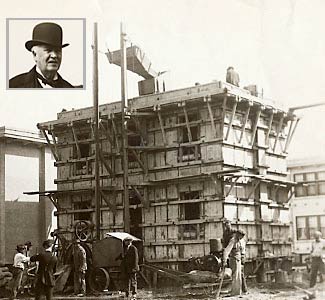Thanks for pointing that out.

2,300-piece nickel plated iron form? Unrepairable/remodelable? Yikes. Maybe 12 built in 1906.
Bucky Fuller built 250 houses in 1923 with his architect father-in-law.
Quote:
|
The Stockade system embedded a concrete frame within enclosing walls of cement-bonded fibrous blocks stabilized by metal clips. It married the strength of an internal supporting frame with the security of masonry walls. The frame was poured-in-place concrete and the walls consisted of the company's lightweight blocks. The dimensions of the blocks, 16 inches long by 8 inches wide by 4 inches high, were based on those of the common brick "as this is the accepted module pleasing to the eye as developed through the ages of architecture." Unlike bricks, the Stockade blocks have a four-inch round hole near each end. As the courses of blocks were laid, concrete was poured into the holes and the blocks served as a mold for the concrete frame. The poured concrete columns connected to concrete lintels at every floor and opening. After the concrete set, the blocks remained in place to protect the frame and function as walls (figure 1.6). Stockade provided a system for the manufacture and construction of a building's structural frame, outer shell, and interior partitions.
|
Similar to modern
Compressed Earth Blocks.
_______________
If you follow Dollard recounting of the history of electrical theory, Tesla doesn't really stand out. I think there's more mention of Steinmetz and Alexanderson, and about how Einstein is wrong on faster than light motion.
He shows a picture of Edison as a bright young man before an explosion on a railroad car damaged his hearing, and compares it to the older man snarling at the camera. He claims all inventors wind up that way. I guess Bucky would be the exception.